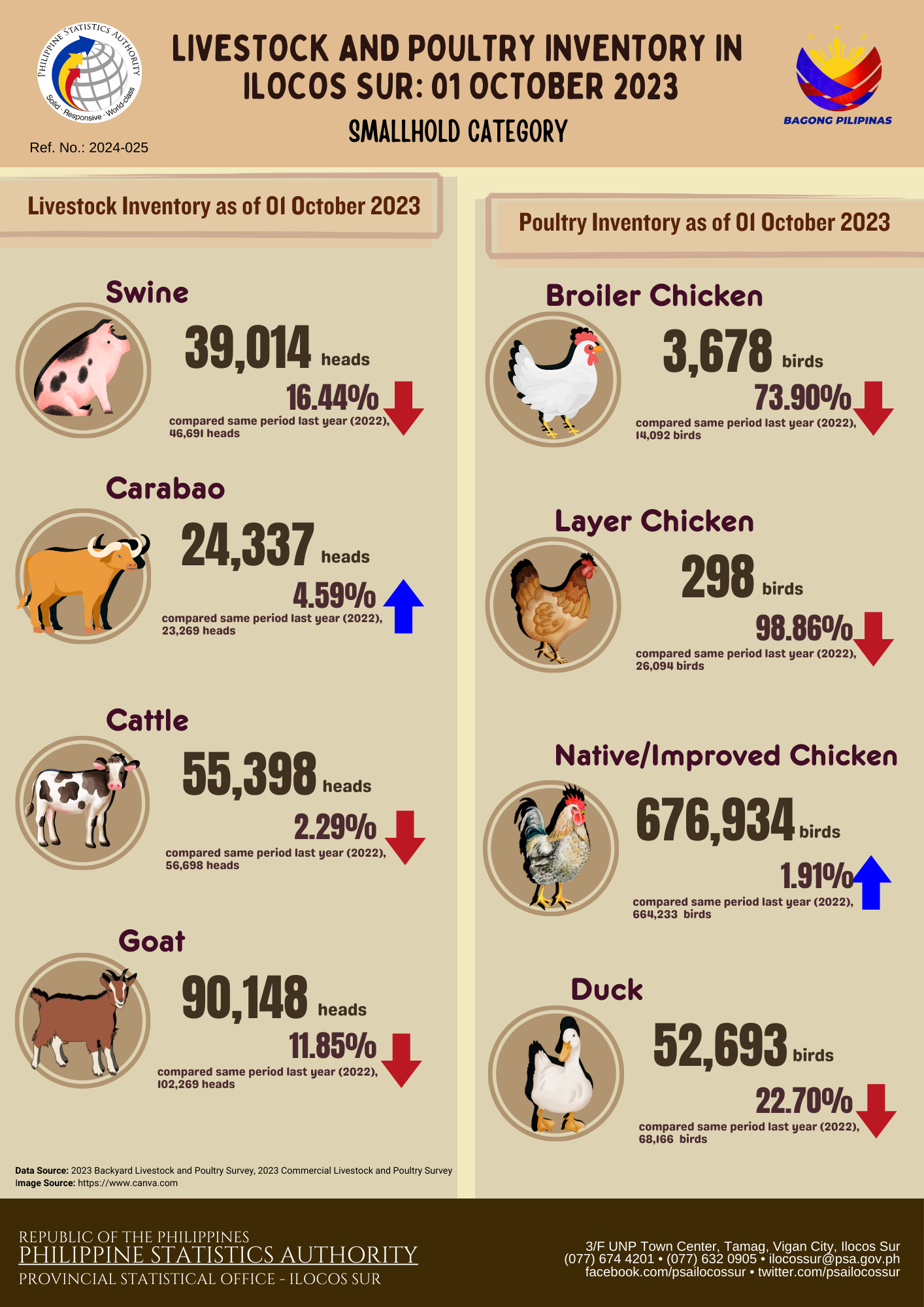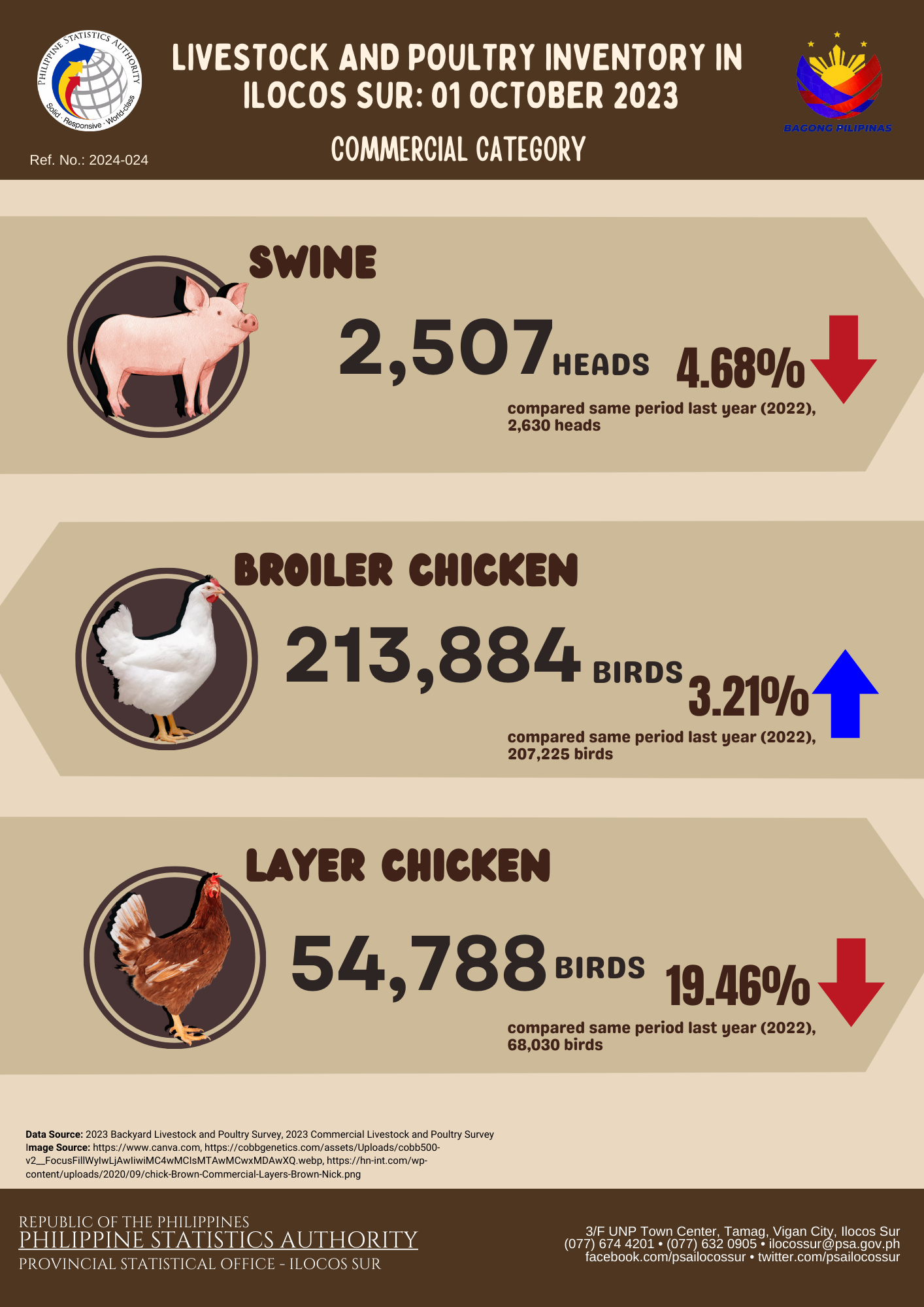The total Livestock and Poultry inventory in Pangasinan stood at 5,876,345 heads as of October 1, 2023. This reflects an 8.4 percent increase compared to the inventory recorded for the same period in 2022, which was reported to be 5,419,517 heads. (Table 1)
Table 1. Livestock and Poultry Inventory by Animal Type,
Pangasinan: Third Quarter 2022-2023  Source: Philippine Statistics Authority
Source: Philippine Statistics Authority
The Livestock inventory went down by 4.1 percent, representing a decrease from 353,821 heads in the third quarter of 2022 to 339,408 heads in the same period in 2023. Carabao, Cattle, and Goat inventories decreased by 17.9 percent, 10.5 percent, and 18.7 percent, respectively, while Swine grew by 20.4 percent.(Table 1)
Meanwhile, Poultry inventory in Pangasinan grew by 9.3 percent, representing an increase from 5,065,696 birds as of October 1, 2022 to 5,536,937 birds for the same reference period in 2023. The growth in the Poultry sector was driven by increase in the inventory of Chicken by 9.8 percent. While Duck inventory declined by 10.7 percent.
Figure 1. Percent Distribution of Livestock Inventory by Animal Type,
Pangasinan: Third Quarter 2023  Source: Philippine Statistics Authority
Source: Philippine Statistics Authority
The Livestock sector, which comprises Carabao, Cattle, Goat, and Swine, reported a total count of 339,408 heads. Swine has the highest contribution to the total Livestock inventory, with 41.4 percent share equivalent to 140,538 heads, followed by the inventory of Goat with 28.9 percent share, amounting to 97,962 heads. Meanwhile, Cattle and Carabao accounted for 18.5 percent and 11.2 percent, with estimates of 62,889 heads and 38,019 heads, respectively. (Figure 1 and Table 1)
Figure 2. Percent Distribution of Poultry Inventory by Animal Type,
Pangasinan: Third Quarter 2023  Source: Philippine Statistics Authority
Source: Philippine Statistics Authority
In terms of the Poultry sector, Chicken inventory with 5,429,729 heads recorded in the third quarter of 2023 surpassed the Duck inventory of 107,208 heads. The total Chicken inventory comprises Broiler, Layer, and Native/Improved. Broiler accounted for 54.3 percent of the total inventory of Chicken with 2,949,807 heads; Native/Improved shared 40.8 percent or 2,212,755 heads, while Layers contributed the least with 4.9 percent, or equivalently 267,167 heads. (Figure 2 and Table 1)
In terms of Livestock slaughtered in slaughterhouses and Chickens dressed in dressing plants in Pangasinan for the third quarter of 2023, a total of 1,441,822 heads were recorded. This reflects a 30.2 percent decline compared to the total count of slaughtered/dressed animals for the same period in the preceding year, which recorded 2,064,398 animals. (Table 2)
Livestock slaughtered in slaughterhouses increased by 9.2 percent, rising from 72,963 heads to 79,687 heads. Meanwhile, the number of Chickens dressed in dressing plants in the province during the same period was estimated at 1,362,135 birds, reflecting a 31.6 percent decline from the 1,991,435 birds recorded in the previous year.
Table 2. Slaughtered/Dressed by Type,
Pangasinan: Third Quarter 2022-2023  Source: Philippine Statistics Authority
Source: Philippine Statistics Authority
In the third quarter of 2023, the number of Hogs slaughtered in slaughterhouses saw an increase of 12.3 percent, rising from 64,634 heads in 2022 to 72,598 heads. Conversely, slaughtered Cattle and Carabao experienced 17.7 percent and 11.0 percent decreases, reaching 4,210 and 2,845 heads, respectively. Meanwhile, there were 34 slaughtered goats recorded in the said period, reflecting a 61.9 percent increase compared to 21 slaughtered Goats in 2022. (Table 2)
Figure 3. Percent Distribution of Livestock Slaughtered In Slaughterhouses,
Pangasinan: Third Quarter 2023 
Source: Philippine Statistics Authority
Out of the recorded 79,687 Livestock slaughtered in slaughterhouses in the province of Pangasinan for the third quarter in 2023, 91.1 percent was Hog, 5.3 percent was Cattle, 3.6 percent was Carabao, and 0.04 percent was Goat. (Figure 3)
The slaughterhouses and dressing plants in the province refers to the premises that are approved and registered by a controlling authority in which food animals/birds are slaughtered and dressed for human consumption. Slaughtering refers to butchering of animal for the purpose of human consumption. While dressing is the progressive separation on the dressing floor of food animal into carcass, offal and inedible by- products.
Table 3. Other Livestock and Poultry Inventory by Animal Type,
Pangasinan: Third Quarter 2022-2023

Source: Philippine Statistics Authority
Furthermore, other animal types falling under the Livestock and Poultry category include Quail, Rabbit, Turkey, Sheep, Goose, and Horse. As of October 01, 2023, the total Quail inventory in Pangasinan reached 40,049 birds, marking a 36.3 percent increase from the 13,500 birds recorded in the same period in 2022. Similarly, the Rabbit inventory for the said reference period in 2023 was 15,033 heads, reflecting a 45.3 percent increase from the previous year's inventory of 10,344 heads. Sheep inventory stood at 2,136 heads, representing a notable 244.5 percent increase from the 620 heads recorded in 2022. However, both Turkey and Goose inventories experienced declines of 17.4 percent and 16.4 percent, with counts of 3,075 and 1,405 birds, respectively. There were no horses recorded in the province as of the said reference date. (Table 3)
Out of the total other animal types under the Livestock and Poultry category as of October 1, 2023, Quail accounted for 45.9 percent, the largest share among the six (6) other animal types, followed by Rabbit with 37.5 percent. Turkey, Sheep and Goose contributed 7.7 percent, 5.3 percent, and 3.5 percent, respectively. (Figure 4)
Figure 4. Percent Distribution of Other Animal Type,
Pangasinan: Third Quarter 2023

Source: Philippine Statistics Authority
As of October 1, 2023, the total inventory of Livestock and Poultry in Pangasinan, including the other six (6) animal types, stood at 5,916,394 heads/birds. The inventory increased by 8.6 percent from the recorded 5,449,386 heads/birds in the third quarter of 2022. (Tables 1 and 3)
EDGAR M. NORBERTE
Chief Statistical Specialist
Pangasinan - Provincial Statistical Office
TECHNICAL NOTES
The Livestock and Poultry Performance Report presents an overview of the performance trends in terms of inventory for carabao, cattle, goat, swine, and various types of chickens, along with the volume of production, including chicken eggs. The data for this special release were meticulously gathered by the Philippine Statistics Authority (PSA) through two primary surveys: (1) The Backyard Livestock and Poultry Survey (BLPS), conducted on a quarterly basis, covers a comprehensive sample size of 280 households. This survey serves to capture the dynamics of livestock and poultry inventory at the household level; (2) The Commercial Livestock and Poultry Survey (CLPS), also administered quarterly, encompasses a broader scope. It involves data collection from various sectors, including 1 carabao farm, 12 cattle farms, 12 goat farms, 6 swine farms, 4 native chicken farms, 11 layer farms, and 16 broiler commercial farms and contract growers, all as of July 1, 2023.
Another survey that supplements the data requirements of the Livestock and Poultry sector is the Compilation of Data Slaughterhouses and Poultry Dressing Plants (CDSPDP). This is done monthly and utilizes administrative data from Locally Registered Meat Establishments (LRMEs) in the province which is in coordination with the Provincial Veterinary Office (PVO) and Meat Inspectors (MIs).
•Livestock – farm animals kept or raised for consumption, work or leisure. In general, poultry is separated as a distinct group of farm animals. For purposes of census and surveys, livestock covers only those that are tended and raised by an operator.
•Poultry – a collective term for all domesticated avian for the purpose of food consumption or, the carcass of such avian dressed/processed for human consumption.
•Animal Inventory (also, Animal Population) – the number of domesticated animals in head present in the farm at specific reference date.
•Dressing – the progressive separation on the dressing floor of food animal into carcass, offal and inedible by-products.
•Slaughter – refers to butchering of animal for the purpose of human consumption.
•Slaughterhouse/Dressing Plant – the premises that are approved and registered by a controlling authority in which food animals/birds are slaughtered and dressed for human consumption.




